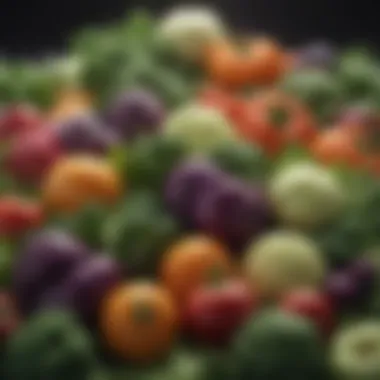Understanding Nitrate Free Foods for Healthy Choices


Intro
In recent years, the conversation surrounding food choices has expanded significantly to include the presence of additives and preservatives. Among these, nitrates have drawn particular attention due to their implications for health. This article delves into the spectrum of nitrate-free foods, assessing their significance, health considerations, and practical benefits for consumers.
Nitrates occur naturally in various vegetables and are also added to processed meats as preservatives. While low levels may not pose an immediate risk, high consumption can be linked to adverse health effects. Understanding which foods are nitrate-free is crucial for those wanting to make informed dietary choices. This overview aims to equip readers with knowledge about nitrate-free options, enhancing their approach to healthier eating habits.
Research Context
Background Information
Nitrates and nitrites are compounds commonly found in foods. They act as preservatives and contribute to food safety. Vegetables such as spinach and lettuce naturally contain nitrates. Nitrates can convert into nitrites in the body, which may lead to the formation of potentially harmful substances. Thus, there is a growing concern regarding their intake.
The sources of nitrates in the diet are diverse. Processed meats, including bacon and hot dogs, often contain added nitrates. Research has revealed correlations between high nitrate consumption and certain health risks, including cancer. This has prompted many health-conscious individuals to seek out nitrate-free foods.
Importance of the Study
This study is relevant as it highlights the need for awareness about nitrate content in foods. As dietary habits evolve, many consumers desire to reduce the intake of preservatives and additives. By exploring nitrate-free foods, we can better understand the alternatives available in the market and their benefits.
Understanding the implications of consuming nitrates has broader significance, especially in the context of public health. Studies indicate that excessive nitrate and nitrite consumption can lead to various health issues, reinforcing the importance of informed dietary choices.
Discussion
Interpretation of Results
Research has indicated that adopting a diet rich in nitrate-free foods can mitigate some health risks linked to high nitrate consumption. The benefits of choosing food options without nitrates extend beyond individual health. They can contribute to improved overall well-being and longevity. While further studies are necessary, current data supports that consumers can enhance their diet by selecting nitrate-free products.
Comparison with Previous Research
Previous studies have raised alarms about the potential dangers of nitrates, particularly concerning processed meats. The evidence has often shown a clear link between high consumption of these products and increased health risks. In contrast, choosing fresh, nitrate-free foods can lower these risks significantly.
The transition from processed to natural foods mirrors a broader trend towards more conscientious dietary practices. Understanding and identifying nitrate-free options aligns with the evolving health landscape, emphasizing a diet rich in whole, unprocessed foods known for their inherent benefits.
Understanding Nitrates
Understanding nitrates is essential in today’s food discussions, especially when we consider its impact on health and dietary choices. Nitrates are compounds that can enter our bodies through various food sources. Their role in our nutrition is complex, and understanding them helps guide decisions that could benefit overall health. This section defines nitrates and explains their primary sources, including natural origins, processed food contributions, and the influence of fertilizers.
Definition of Nitrates
Nitrates are naturally occurring compounds composed of nitrogen and oxygen. They are commonly found in the environment, especially in soil and water. When we consume nitrates, our body can convert them into nitrites, a process that has gained considerable attention due to its health implications. It is important to recognize that while nitrates in moderation are generally safe, their excessive consumption can lead to potential risks, which is why understanding this compound is an integral part of evaluating food choices.
Sources of Nitrates
Sources of nitrates can be categorized into three main types: natural sources, processed foods, and fertilizers. Each of these sources contributes differently to our overall nitrate intake and awareness of them can inform healthier eating habits.
Natural Sources
Natural sources of nitrates predominantly include certain vegetables. Root vegetables, leafy greens, and some fruits contain varying levels of nitrates. For instance, spinach, beets, and lettuce stand out with higher concentrations. The key characteristic of these natural sources is their health-promoting compounds, as they provide essential nutrients alongside nitrates. They are often considered a beneficial choice in various diets due to their rich vitamins and antioxidants. However, it is also critical to recognize that not all natural sources are nitrate-free. Thus, proper identification and selection are important when aiming for a nitrate-reduced diet.
Processed Foods
Processed foods often contribute significantly to dietary nitrate levels. This includes charcuterie products like bacon, ham, and sausages, in which nitrates are introduced as preservatives and flavoring agents. Notably, the primary characteristic of processed foods is their convenient nature and extended shelf life. However, frequent consumption of these products does present downsides. The addition of nitrates in processed foods can potentially lead to the formation of harmful compounds like nitrosamines during cooking. Consumers looking to minimize nitrate intake should be cautious about processed food diets, as they often contain not just nitrates but also other preservatives and additives.
Fertilizer Influences
Fertilizers play a pivotal role in the nitrate levels present in food crops. High-nitrogen fertilizers are widely used in conventional farming. This agricultural practice often leads to increased nitrate content in fruits and vegetables, impacting both safety and flavor. The essential characteristic of fertilizers lies in their ability to enhance crop yield. Nonetheless, the consequences may include excess nitrates leaching into food supplies, resulting in concerns about dietary safety. Awareness of fertilizer influences is important for making informed choices, especially when buying produce from different sources.
Health Implications of Nitrate Consumption
The topic of health implications regarding nitrate consumption is important to understand for making informed dietary choices. Nitrates are naturally occurring compounds found in various foods, and their effects on health are complex. On one side, they can lead to certain health risks; on the other, they may also offer benefits. Analyzing these aspects helps consumers navigate their choices wisely.


Potential Risks
Nitrosamines Formation
Nitrosamines are compounds formed when nitrates react with amino acids in the stomach. This transformation can occur under acidic conditions, common in the digestive process. Nitrosamines are notable because many of them are classified as potential carcinogens, raising concerns about food safety and long-term health impacts.
The unique feature regarding Nitrosamines is their connection to food processing methods. Processed meats are often the primary source of nitrosamines, which makes understanding label contents essential. It indicates the potential dangers of consuming processed foods high in nitrates, placing emphasis on the necessity of choosing nitrate-free options whenever possible.
Blood Pressure Concerns
Blood pressure is another critical area affected by nitrate consumption. While nitrates can help lower blood pressure due to their natural vasodilatory effects, excessive intake, mainly from processed food, may lead to adverse effects. High blood pressure can contribute to heart disease and stroke, making it vital to monitor intake levels.
An interesting characteristic of Blood Pressure Concerns is how the source of nitrates affects outcomes. Nitrates obtained from vegetables typically do not pose the same risk as those from processed meats. It shows health-conscious consumers should explore natural sources of nitrates versus synthetic ones found in many packaged foods.
Impacts on Cancer Risk
Research highlights a potential connection between nitrate consumption and cancer risk. Specifically, the focus lies on the conversion of nitrates to nitrites and subsequently to nitrosamines. Nitrate-rich diets mainly from processed sources can amplify this risk, reinforcing the need for awareness.
This aspect is significant because it illustrates a broader concern for dietary patterns. Prioritizing fresh fruits and vegetables, which contain lower levels of harmful nitrates, can effectively mitigate cancer risks. Consumers need to be aware of the long-term implications of their dietary habits to reduce exposure to carcinogenic substances.
Benefits of Nitrates
Although nitrate consumption has associated risks, there are also benefits worth exploring—especially in relation to cardiovascular health and athletic performance.
Role in Cardiovascular Health
Nitrates, particularly those derived from vegetables such as beets and leafy greens, have been found to support cardiovascular health. They assist in improving endothelial function and overall blood flow. Such benefits are crucial for maintaining heart health and preventing cardiovascular diseases.
The key characteristic surrounding this aspect is the way nitrates are metabolized into nitric oxide, which helps in vasodilation. Improved blood flow can provide significant advantages for both overall health and exercise performance, positioning nitrates as a beneficial component in a balanced diet.
Exercise Performance Enhancement
Nitrates can enhance exercise performance, especially during high-intensity workouts. Athletes often use nitrate supplements or consume foods high in nitrates to boost endurance. Research indicates that dietary nitrates can improve oxygen utilization and reduce fatigue onset.
The unique feature of this aspect is its practical application for athletic training. Nitrates are more than just a health concern; they serve as a potential ally for athletes. Incorporating nitrate-rich foods allows for an enhancement in performance, creating a synergy between diet and physical exertion.
Understanding the balance between the benefits and risks of nitrate consumption is essential for making judicious lifestyle choices.
In summary, the health implications related to nitrate consumption encompass a broad spectrum of potential risks and benefits. It is crucial to be aware of not just what we consume but where these nitrates come from, in order to build a diet that emphasizes health and well-being.
Identifying Nitrate-Free Foods
Identifying nitrate-free foods is crucial for those looking to minimize their nitrate intake and adopt a healthier diet. Nitrates are naturally occurring compounds found in various foods, but their presence can pose health risks, especially when consumed in excess. By understanding how to identify foods that are low in nitrates, consumers can make informed choices that align with their health goals.
Labeling and Certification
Understanding Labels
Labels on food products provide essential information regarding the presence of nitrates. When shopping, it is important to check for terms like "nitrate-free" or "no added nitrates" clearly displayed on packaging. These labels are significant as they confirm that no nitrates were used in preserving or processing the food. This aspect is appealing for individuals who are cautious about their dietary choices and prefer consuming products free from artificial additives. Additionally, it can enhance consumer confidence in the quality and safety of the food.
However, some products may still contain small amounts of naturally occurring nitrates, which leads to a gray area in labeling. Therefore, consumers should not only rely on labels but also look into the overall ingredient list for assurance.
Significance of Certifications
Certifications play an important role in identifying nitrate-free products. Foods that carry certifications, such as USDA Organic or Non-GMO Project Verified, often meet strict standards regarding additives and must comply with regulations that limit nitrates. These certifications provide a level of third-party validation that consumers can trust.
The benefit of such certifications is that they not only indicate lower nitrate levels but also often ensure higher quality and more sustainable farming practices. For those serious about dietary health, seeking out certified products can be a beneficial choice. However, it is also essential to understand that certifications can sometimes increase prices, so consumers must weigh the benefits against their budget.
Food Categories to Consider


Identifying nitrate-free foods can be more manageable when breaking down food categories. Each category reveals options with naturally lower nitrate levels, guiding consumers towards healthier choices.
Fruits and Vegetables
Fruits and vegetables are naturally low in nitrates and should be a staple in any diet focused on minimizing nitrate intake. Fresh, whole fruits like apples, berries, and oranges, along with vegetables such as bell peppers and carrots, are excellent choices.
The key characteristic of these foods is their nutrient density. They not only offer a wide range of vitamins and minerals but also provide dietary fiber, which is important for digestive health. Preparing them can be simple, often requiring just washing, cutting, or roasting to enhance their natural flavors without the need for processed dressings.
Meat and Poultry
When it comes to meat and poultry, choosing fresh cuts is critical for avoiding nitrates. Products labeled as "no nitrates" or "nitrate-free" are ideal as they indicate no added preservatives. Among these, options like chicken breasts, grass-fed beef, or pork can provide high-quality protein without unnecessary additives.
A common misperception is that all processed meats are high in nitrates; however, there are nitrate-free options available. Focusing on unprocessed meats is a beneficial strategy. By doing so, consumers avoid the negative health implications associated with nitrites typically found in processed meats.
Dairy Products
Dairy products might seem an unlikely source of nitrates, but certain ones can contain added nitrates or preservatives. Opting for organic or raw dairy options often ensures the absence of added nitrates. Items like whole milk, yogurt, and cheese can be healthy parts of a no-nitrate diet.
The advantage of dairy is not just in taste; they provide calcium and other essential nutrients beneficial for bone health. For many, dairy can serve as a satisfying way to incorporate diverse nutrients without raising concerns about dietary nitrates.
Grains and Legumes
Grains and legumes also present a path for consumers to stay clear of nitrates. Examples like quinoa, brown rice, lentils, and chickpeas are naturally low in these compounds. Incorporating these foods can enhance a balanced diet while providing energy and essential proteins
A notable benefit of grains and legumes is their versatility in various diets, accommodating vegetarian or plant-based preferences. They can be enjoyed in salads, soups, or as side dishes while ensuring a low-nitrate option.
Overall, understanding how to identify nitrate-free foods is an essential skill for consumers who prioritize their health. Whether through careful labeling, supportive certifications, or awareness of food categories, each choice contributes to a healthier diet.
Examples of Nitrate-Free Foods
Understanding the examples of nitrate-free foods is essential for those seeking to minimize nitrate intake in their diets. These foods offer alternatives that are not only safe from high nitrate levels, but they also contribute to overall nutritional health. By learning about specific nitrate-free options, individuals can make informed choices that align with their health goals.
Fruits and Vegetables
List of Nitrate-Free Options
Fruits and vegetables play a vital role in a nitrate-free diet. Not all produce contains high levels of nitrates. Some specific options that are considered low in nitrates include apples, bananas, broccoli, cauliflower, and cucumbers. These items are beneficial due to their low levels of naturally occurring nitrates and their richness in vitamins and minerals. A major characteristic of this list is their accessibility. Most people can find these fruits and vegetables at local markets or grocery stores.
The unique feature of choosing these nitrate-free fruits and vegetables is their health benefits. They provide essential nutrients without the potential risks associated with high nitrate consumption, making them a popular selection for health-conscious individuals. In this article, these options contribute significantly to a balanced diet while promoting better overall health.
Preparation Methods
How you prepare fruits and vegetables can also make a difference in maintaining their nitrate-free status. Common methods such as steaming, roasting, or eating them raw are effective ways to keep these foods healthy. Each method retains the nutrients and flavor, making them appealing choices for meals.
A key characteristic of these preparation methods is their simplicity. They require minimal equipment and time, allowing individuals to easily incorporate them into their daily meals. The primary advantage is that these methods do not introduce any harmful chemicals or additional nitrates, keeping the food as pure as possible. However, overcooking can lead to nutrient loss, so it’s essential to use methods that maintain their nutritional integrity.
Nitrate-Free Meats
Choosing Fresh Cuts
When it comes to meats, choosing fresh cuts is crucial for maintaining a nitrate-free diet. Fresh meats like chicken, turkey, and beef offer protein without the preservatives often found in processed alternatives. A significant aspect of selecting fresh cuts is examining the packaging for added ingredients. Sometimes, fresh meat can be labeled as 'nitrate-free,' ensuring that nitrates have not been introduced during processing.
The unique feature of selecting fresh cuts is the quality and freshness of the meat itself. Fresh cuts not only provide better flavor but also support healthier eating habits. They do require more attention in terms of proper storage and cooking, which may be seen as a disadvantage for some. Nevertheless, the health benefits of these choices can far outweigh any inconvenience.
Processed Meats to Avoid
Processed meats are often high in nitrates due to the curing and preservation methods used. It is essential to avoid products like bacon, hot dogs, and deli meats unless they are explicitly labeled as nitrate-free. The concern with processed meats is that they commonly contain additives that can pose health risks.
A key characteristic of these processed options is their prevalence in many diets. They often appear convenient and tasty but come with increased health implications. The unique feature of this avoidance is the protection from associated risks, such as increased blood pressure and potential cancer risk. Limiting these products can lead to significant health improvements in the long run, supporting the overall goals of this article.


Practical Tips for Incorporating Nitrate-Free Foods
Incorporating nitrate-free foods into one’s diet is essential for promoting health and wellness. Understanding practical strategies can aid individuals in making informed choices. This section provides actionable tips to help achieve a balanced, nitrate-free eating routine. By utilizing effective meal planning and purchasing strategies, one can experience the benefits of a nitrate-free lifestyle.
Meal Planning Strategies
Planning meals helps ensure that dietary habits align with health goals. Thoughtful meal planning enables the selection of nutrient-rich, nitrate-free foods that contribute to better health.
Creating Balanced Meals
Balanced meals consist of the right proportions of proteins, carbohydrates, and fats. When focusing on creating balanced meals, it is vital to include a variety of vegetables and fruits that are naturally low in nitrates. Some examples include berries, apples, leafy greens, and bell peppers. This variety provides essential vitamins and minerals while minimizing unhealthy additives.
It is a beneficial choice because it helps maintain overall nutritional balance without relying on processed foods that may lead to higher nitrate intake. Incorporating healthy fats, such as avocado and nuts, can enhance the absorption of fat-soluble vitamins. In this regard, it addresses both dietary satisfaction and nutritional requirements.
The unique feature of balanced meals is that they promote satiety, preventing excessive snacking and overeating. However, careful attention is necessary to ensure that portion sizes align with personal dietary needs.
Batch Cooking Nitrate-Free Options
Batch cooking is an effective strategy for saving time and ensuring access to nitrate-free meals throughout the week. Preparing larger quantities of nitrate-free dishes, like grilled chicken, quinoa, or roasted vegetables, allows for quick reheating on busy days. This method is advantageous for those with tight schedules, as it encourages healthier eating without extra time commitment each day.
One defining characteristic of batch cooking is its ability to minimize food waste. Leftovers from one meal can easily be repurposed in another, ensuring that all ingredients are used effectively. Consistently cooking nitrate-free meals can create habits that enhance long-term health without much effort.
However, a potential downside includes the risk of monotony. It may be wise to plan different recipes for batch cooking to keep meals interesting and enjoyable.
Buying Tips
When shopping for nitrate-free foods, choices made in the grocery store significantly impact overall diet quality. Utilizing strategic buying tips can ensure that one acquires the best products available, encouraging the consumption of nitrate-free options.
Shopping for Local Produce
Shopping for local produce can be a major advantage in ensuring food freshness and quality. Local fruits and vegetables often contain lower levels of nitrates compared to those mass-produced with various fertilizers. Supporting local farmers also promotes sustainable agricultural practices. This is especially important for the health of the community and environment. It is a popular choice for health-conscious individuals who want to reduce exposure to harmful additives often present in processed foods. Additionally, reducing food miles from farm to table can contribute to a smaller carbon footprint. One unique feature of local produce is its seasonal availability, which can inspire a diverse array of meals. However, access may be limited depending on geographic location and the season.
Choosing Organic Whenever Possible
Choosing organic foods can significantly lower the risk of nitrate consumption, especially in fruits and vegetables. Organic farming practices restrict synthetic fertilizers, thus leading to reductions in nitrate levels. This choice aligns well with a health-focused dietary plan, promoting both individual wellness and environmental sustainability.
The key characteristic of organic foods is the emphasis on natural cultivation methods. These foods tend to carry more nutrients and are generally free of harmful pesticides.
However, organic products may come at a higher price point. Evaluating the costs versus health benefits is essential for consumers as they seek to incorporate these items into their diets. Determining priorities, such as maximizing nutritional content or affordability, will shape individual shopping habits.
Incorporating practical tips for adopting nitrate-free foods promotes healthier eating habits and can significantly enhance well-being. Paying attention to meal planning and shopping methods is crucial in this endeavor.
The Role of Nitrate-Free Foods in Specific Diets
Nitrate-free foods play a significant role in various dietary frameworks. Their importance lies in the preference for clean eating, awareness of health implications, and adaptations to specific nutritional goals. People following specialized diets are often vigilant about ingredient transparency and food quality. Dietary choices such as Paleo, Whole30, Vegetarian, and Vegan emphasize the consumption of whole, unprocessed foods, many of which are low in nitrates. Understanding this aspect allows individuals to make more informed choices that align with their health needs and lifestyle preferences.
Paleo and Whole30
The Paleo diet focuses on consuming foods that were available to our hunter-gatherer ancestors. This includes lean meats, fish, fruits, vegetables, nuts, and seeds while avoiding processed foods, dairy, and grains. Nitrate-free foods fit well within this framework, as most processed foods are likely to contain added nitrates, especially in cured meats. Following a Paleo diet, one would prefer fresh meats from grass-fed sources, such as ribeye or tenderloin, along with a variety of colorful vegetables like bell peppers and spinach.
Similarly, the Whole30 program promotes a 30-day reset of one’s eating habits, focusing on whole foods without added sugars, grains, legumes, dairy, and alcohol. The emphasis on avoiding processed foods aligns perfectly with the goal of consuming nitrate-free options. For adherents, incorporating plenty of nitrate-free vegetables like zucchini and cauliflower is straightforward. Avoiding sugary sauces and cured foods ensures that both nitrate and added sugar consumption is minimized.
Vegetarian and Vegan Diets
Vegetarian and vegan diets center around plant-based eating, making it easier to avoid nitrates, as many plant foods are naturally low in these compounds. Vegetarians, who may include eggs and dairy, benefit from nutrient-dense foods, emphasizing fresh produce. Selecting organic berries, organic greens, and whole grains can further help limit nitrate intake.
Vegans, who exclude all animal products, also rely heavily on fruits, vegetables, legumes, and grains. When planning meals, nitrate-free legumes such as lentils and chickpeas can be advantageous for protein. Fruits like apples and oranges may be included without concern over nitrates, making them excellent snacks or additions to meals.
Choosing a diet low in nitrates can support overall health and minimize potential risks without compromising nutritional value.
The End: The Future of Nitrate-Free Foods
The exploration of nitrate-free foods is increasingly relevant in today's health-conscious environment. As consumers become more informed about what they eat, the preference for nitrate-free options is expected to grow. This trend plays a crucial role in shaping dietary habits and influencing food production practices. It enhances individual health choices while also putting pressure on the food industry to meet these demands.
Consumer Trends and Preferences
Recent studies indicate a significant shift in consumer behavior. More individuals are prioritizing health and nutrition in their food choices. The awareness of nitrates and their potential health impacts—such as their association with nitrosamines formation—has prompted many people to actively seek out nitrate-free alternatives. Organic products are performing well, especially as consumers link them with cleaner food sources.
The rise of social media platforms has contributed to this shift. Engaging content on nitrate-free foods, health tips, and recipes encourages discussions and community support around healthier choices. Groups and forums on platforms like Reddit further allow consumers to share experiences and advice. This exchange not only promotes awareness but also cultivates a culture centered on informed eating.
Implications for Food Industry
The food industry faces considerable challenges and opportunities due to the rising popularity of nitrate-free foods. Companies are adapting by reformulating existing products and creating new ones that align with the demand for healthier options.
Food manufacturers might adopt transparent labeling practices, providing consumers with clearer information on nitrate content and sourcing. Moreover, brands that succeed in promoting nitrate-free products can tap into a growing market segment focused on health and wellness.
As production shifts, it's likely there will be an increase in organic farming practices and a reduction in the use of synthetic fertilizers, which are a significant source of nitrates. In response, some businesses are investing in sustainable farming to appeal to the environmentally-conscious consumer. The focus on nitrate-free foods can potentially lead to a more diverse and innovative food market overall.
"The future of nitrate-free foods is not just a trend; it's a statement about personal health and environmental responsibility."















